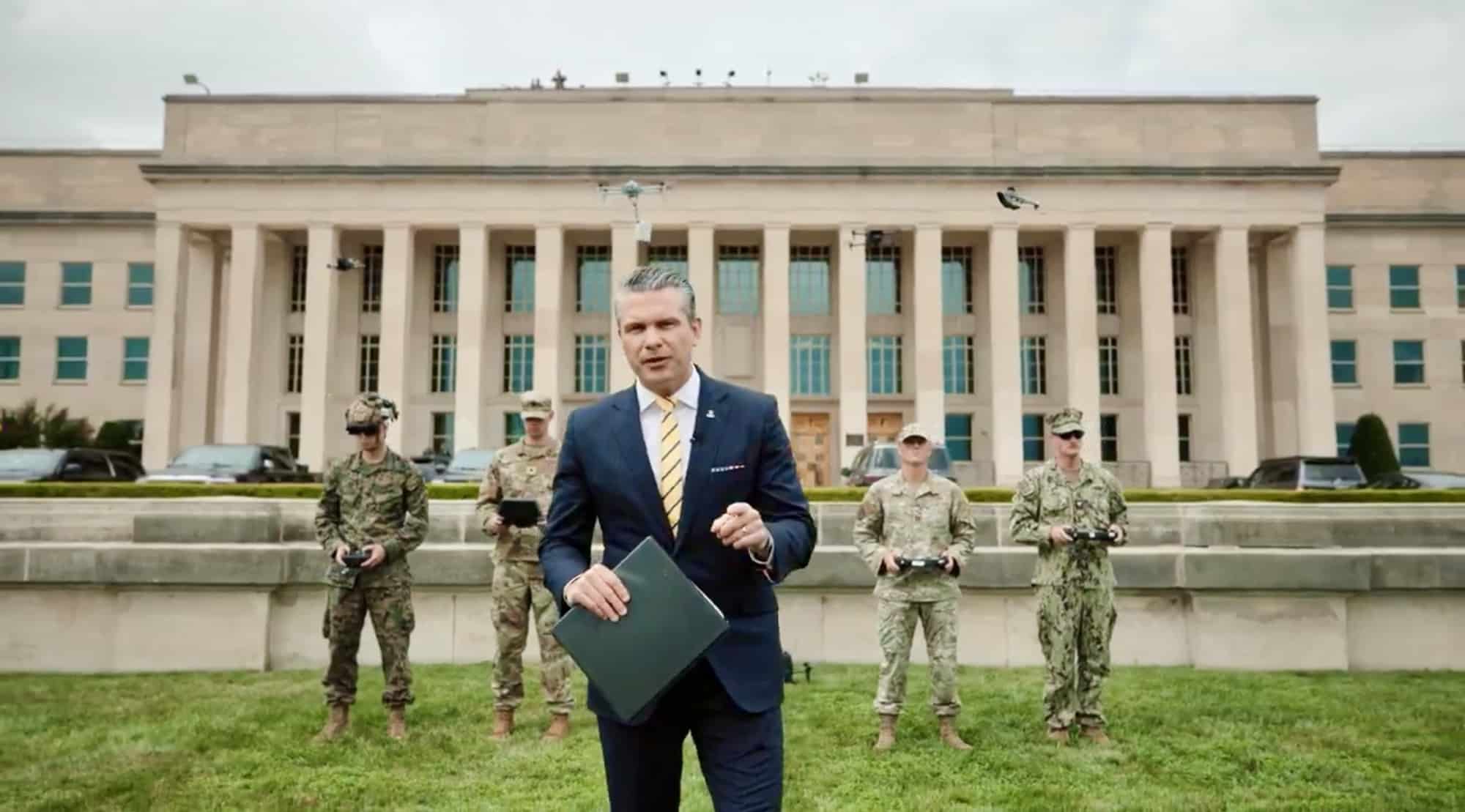U.S. Defense Secretary Hegseth’s Directive: The Pentagon’s New Drone Dominance Strategy
The United States military stands on the precipice of a major transformation. In July 2025, Defense Secretary Pete Hegseth initiated an assertive new strategy aimed at establishing American dominance in drone warfare. This move involves expediting Pentagon processes, reforming procurement systems, and equipping each squad with drones by 2026. Think of it as a necessary alarm for a military encumbered by bureaucracy, now scrambling to reclaim the “drone dominance” potentially forfeited to nations like Russia and China.
Why the Urgency? The Global Drone Surge
Drones have emerged as the most significant battlefield innovation of this generation, prominently featured in current conflicts, notably in Ukraine where they’re responsible for much of this year’s combat casualties. It’s moved beyond just surveillance; affordable, expendable “kamikaze” drones and commercial models are reshaping the rules of engagement.
“Our adversaries are collectively producing millions of cheap drones annually… US units lack the lethal small drones necessary for the modern battlefield,” — Pete Hegseth
The perceived threat lies in the vast production capabilities of adversaries, producing low-cost drones at an industrial scale, compared to America’s slower, risk-averse, and bureaucratic acquisition processes. The new directive aims to counter this trend swiftly, challenging existing processes.
What’s Actually Changing? Major Overhauls Unpacked
1. Equipping Every Squad with Drones (by end of 2026)
- Every Army squad will be supplied with small, expendable attack drones as part of their standard equipment, not in five or ten years, but within eighteen months.
- The Indo-Pacific combat units are receiving immediate priority, reflecting Pentagon concerns about China’s capabilities and regional strategic significance.
2. Cutting Bureaucracy and Empowering Commanders
- Red tape is being slashed with multiple legacy Pentagon policies restricting drone acquisition and field modifications being rescinded.
- Commanders as low as Army colonel or Navy captain can now independently purchase and test drones, even experimental and 3D-printed models, without extensive approvals.
- Small drones will now be treated as consumable items, rather than long-term assets, allowing units to deploy and replace them rapidly as needed.
3. Supercharging American Drone Manufacturing
- The directive calls for the identification and approval of “hundreds” of U.S.-made drone products for immediate military acquisition.
- There’s a focused effort to scale procurement channels, boosting domestic innovation to match foreign production levels.
- All military branches must establish experimental units to focus on scaling small UAS (uncrewed aerial systems) programs by September 2025.
4. Revolutionizing Training and Doctrine
- By 2026, all major training exercises will incorporate drones, including mock “force-on-force drone wars” where both sides utilize and defend against unmanned systems.
- UAS capabilities are to be emphasized in “all relevant combat training” by next year, ensuring troops acquire practical, real-world experience.
5. Deadlines and Accountability
- 60 days: Military departments must pinpoint programs that could be replaced or supplemented with drones for enhanced effectiveness or cost savings.
- 90 days: Designation of at least three national training ranges across diverse terrains, including over water, for “deep UAS training.”
- 2027: Aim for “UAS domain dominance,” with the goal of setting a global standard in small drone warfare by this year.
The Human and Cultural Side
Hegseth’s approach transcends hardware; it’s about cultural change, shifting to a “Department of War culture” that encourages risk-taking and bold adaptation over bureaucratic caution. The new policy was symbolically launched with Metallica’s “Enter Sandman” playing, while a quadcopter delivered the signed memo on the Pentagon lawn, showcasing the urgency and boldness of the new approach.
“Lethality will not be hindered by self-imposed restrictions, especially when it comes to harnessing technologies we invented but were slow to pursue.” — Pete Hegseth
Real-world Implications: What Will Change?
On the Battlefield:
- Squads launching drone attacks independently, rather than awaiting centralized air support.
- Soldiers modifying and repairing drones on-the-fly based on immediate mission requirements.
- Utilizing swarms of drones for both offensive and defensive operations, being cheap, fast, and expendable.
For the Defense Industry:
- Both startups and traditional contractors have opportunities as the Pentagon opens doors to non-traditional suppliers specializing in AI, robotics, and rapid prototyping.
- A focus on American-made technologies to address concerns about supply chain security and foreign control points.
For Training and Doctrine:
- Expect “drone-on-drone” competitions akin to how cyber warfare exercises became standard a decade ago.
- Potential development of a new class of “drone operator” specialists as autonomy and hands-on experience are emphasized among troops and commanders.
Key Innovations and Technological Leapfrogging
- 3D-printed drones: Allow for rapid prototyping and field adaptation.
- AI-powered autonomy: Offers smarter navigation, dynamic targeting, and adaptive swarming tactics.
- Consumables: Treating drones like munitions encourages quick deployment and replacements.
What’s at Stake? The Race with Russia and China
China reportedly produces millions of cheap drones annually, and Russia’s use of Iranian-manufactured “kamikaze” drones in Ukraine demonstrates how dynamically the battlefield can change. Hegseth emphasizes that the U.S. must not only catch up but surpass adversaries by leveraging its unmatched innovative culture.
Challenges Ahead
- Supply chain security: Ensuring all drone components are either American-made or thoroughly vetted for security.
- Counter-drone measures: As drones become widespread, so will the need for defense mechanisms against opposing systems, including jammer technology and electronic warfare.
- Ethical and legal concerns: The rapid deployment of autonomous weaponry raises issues of accountability, civilian safety, and engagement rules.
The Human Touch: Innovation Teams and Field Stories
Troops and tech-savvy teams on the front lines will be empowered to “hack” drones to fit their specific needs. Imagine a Marine squad in the Pacific printing reconnaissance drones overnight from digital files, or Army engineers modifying commercial quadcopters to transport novel payloads as needed. This echoes traditional military resourcefulness—think “The A-Team” with AI-powered drones.
The Big Picture: America’s Commitment to Drone Leadership
Hegseth’s directive is more than a procurement change; it’s a cultural revolution inviting the entire defense sector to operate at the pace of war. It’s a rallying cry for tech innovators, veterans, and policymakers to redefine what it means to be a dominant military force in this decade.
“Accelerating this critical battlefield technology necessitates a Department of War culture. Senior officers must lead by example.” — Pete Hegseth
In summary, the Pentagon’s new drone dominance directive represents a comprehensive overhaul of how the U.S. engages in warfare, acquisition, and innovation. If successful, this initiative will not only write a new chapter in military technology history but will also see American squads enter battle not just with rifles, but equipped with personalized fleets of flying robots at their disposal.













